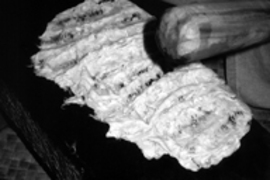
Pua is in her seventies now; the more arduous tasks of kapa-making she must leave to daughter Kapua, who has sat at her mother’s side since childhood, learning the craft in the traditional way of alaka‘i (apprentices), by observation and practice. “When we’re sitting in the halau, all the knowledge is being given to me without a lot of speaking,” says Kapua. “Don’t get me wrong—we laugh and have fun, but when it comes to the kapa, it’s a silent transmission from mother to daughter of everything she’s learned and done. I’m not in a rush to graduate. There’s so much to learn, it’ll take another lifetime.
“In the very beginning, Mom would make a piece and ask my dad and me what we thought of it, and we’d say it was nice. And she’d say, ‘Nah, not good enough.’ And she’d rip it up, months of work, and start over. Now I understand. If you’re going to do it, you have to do it right. That’s what the Hawaiians did.
“I am so in awe of what I have from my mom. People I?meet ask what I do. I say, ‘Well, sit down. It’s not a simple answer.’
“Kapa grabs you and brings you in, and then you’re lost,” Kapua says, then shakes her head. “No. You’re found.”
Pua with a wauke sapling.






i feel we have a lot to appreciate the continuance of a knowledge almost lost from the bottom of my heart thanks to all